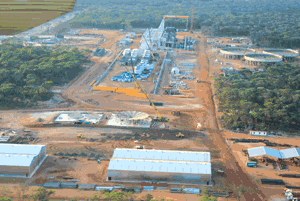In mid-December, First Quantum provided updates on its major copper development projects in Zambia and reported that it intends to publish the revised capital cost estimate and project schedule for its Cobre Panama project in Panama in the first quarter of 2014.
 |
| First Quantum’s $1.9 billion Sentinel project in Zambia is on schedule for commissioning in the second half of 2014. |
In Zambia, an expansion of the Kansanshi mine’s oxide circuit throughput capacity to 14.5 million mt/y was completed and the first copper cathode was plated in November. Full utilization of the expanded solvent extraction/electrowinning (SX/EW) processing capacity is expected once First Quantum’s new Kansanshi copper smelter is in operation and providing sulphuric acid as a by-product. This acid will be used in the SX/EW process, thereby eliminating the need to purchase sulphur to produce sulphuric acid.
Construction at the new copper smelter was approaching peak levels in December, and commissioning was intended to begin in mid-2014. The smelter will have capacity to process 1.2 million mt/y of copper concentrates and is expected to produce 300,000 mt/y of copper and 1 million mt/y of sulphuric acid.
The smelter is scheduled to be operating at 80% of its design capacity by mid-2015 and at 100% in early 2016. It will process a combination of concentrates from both Kansanshi and First Quantum’s new Sentinel mine, currently under construction.
Capital cost for the smelter is projected at about $690 million. In addition to the anticipated savings related to the production of sulphuric acid, the proximity of the smelter to the First Quantum mines is expected to benefit the company’s overall transportation costs by between $130 million and $200 million/y.
The Sentinel project remains on schedule and on budget for commissioning in the second half of 2014. Capital cost to develop the project is estimated at $1.9 billion.
Sentinel’s processing facility will have a target throughput rate of 55 million mt/y at an average grade of 0.5% copper. Higher grades are expected in the first six years of the mine life, which would provide annual production ranging between 270,000 mt and 300,000 mt of copper in concentrates.
The First Quantum project update included the observation that, “It has become obvious that the availability of in-country, third-party smelting capacity in Zambia is declining to the extent that even with the completion of the company’s current smelter project, there will be insufficient capacity to process all of the concentrate production from Sentinel and Kansanshi.”
As a result, First Quantum is planning to design and build an expansion to the new copper smelter and to defer completion of a previously announced Kansanshi sulphide ore expansion until 2017, when the smelter expansion is targeted to be complete. While planning is in the early stages, the company anticipates the smelter expansion will increase throughput capacity to 2 million mt/y.
In Panama, First Quantum has been focusing on reviewing and stabilizing activities at the Cobre Panama project, which it acquired in March 2013. Since that time, the project has transformed from an out-sourced approach to a complete in-house, self-perform arrangement, where third-party engineers and contractors are now utilized only for identified specific tasks. The earthworks have been the subject of critical review, as has the methodology of subsequent excavation and construction.
First Quantum has purchased significant quantities of on-site equipment from contractors whose contracts have been either canceled or modified. This is enabling First Quantum to fully control all site development activities. Site accommodation, road access, communications, and management are now all fully functional and allowing the major activities to advance efficiently.
First Quantum chairman and CEO Philip Pascall said, “The update on the Cobre Panama project early in 2014 will be the culmination of a comprehensive review and re-engineering of all aspects of the project’s development to ensure an appropriate return on investment and the most efficient use of our financial and human resources. We had intended to publish the update earlier; however, we have had to correct a number of acquired technical and logistical shortcomings, so it is taking slightly longer than anticipated. Nevertheless, our priority is to make sure this project is positioned to allow its development to proceed in accordance with our exacting standards.”









